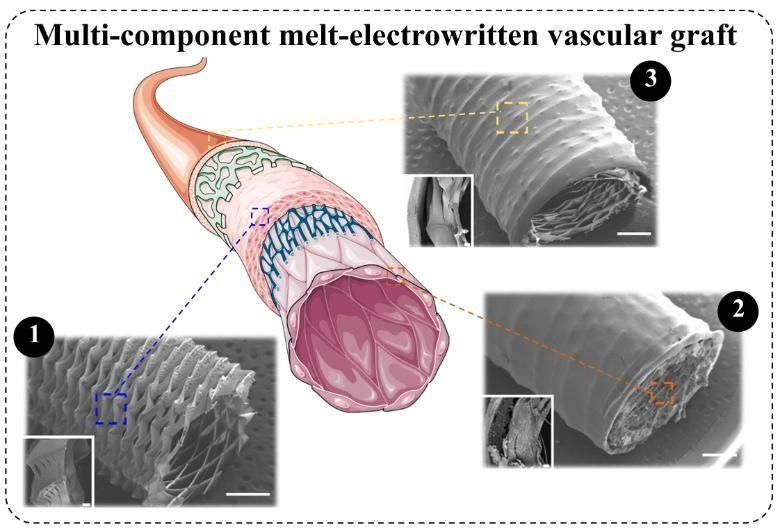Hybrid Grafts to Combat Cardiovascular Disease
|
By HospiMedica International staff writers Posted on 26 Aug 2024 |

Cardiovascular disease (CVD) remains a leading health concern, often requiring vascular grafts for treatment. These grafts, however, frequently encounter complications such as compliance mismatch and clot formation, particularly when used in small-diameter applications. To address this, researchers have developed a multicomponent vascular graft that mimics the native architecture of blood vessels, aiming to enhance the regeneration of damaged tissue.
Researchers from Trinity College Dublin (Dublin, Ireland), as reported in the international journal Advanced Functional Materials, employed a Melt electrowriting (MEW) technique to create this advanced vascular graft. This method allows for the fabrication of tubular scaffolds that not only exhibit vascular-mimetic fiber architecture and mechanics but are also integrated with a lyophilized fibrinogen matrix, designed to degrade at a controlled rate. This hybrid graft aligns with ISO implantability standards, matches the compliance of natural vessels, and has been shown to support physiological flow while minimizing clot formation in preclinical models.
In practice, the graft was successfully implemented as a replacement for the abdominal aorta in rat models, where it demonstrated excellent blood compatibility by reducing platelet and red blood cell infiltration. This breakthrough introduces a promising off-the-shelf solution for small-diameter vascular grafts needed in CVD treatment. Additionally, the innovation supports the broader development of 3D bio printed biological implants aimed at regenerating, rather than merely replacing, diseased tissues and joints.
“We developed a novel multicomponent vascular graft that was inspired by the layered architecture of native blood vessels,” said Associate Professor David Hoey, lead investigator and study author. “Utilizing advanced biofabrication technologies such as melt electrowriting (MEW) we could produce tubular scaffolds, that when combined with a fibrinogen matrix, could not only replicate the behavior of a blood vessel but could also act as a guiding structure to regenerate damaged tissue. This exciting off-the-shelf graft meets clinical requirements and is therefore a promising solution for addressing the unmet need for small-diameter vascular grafts.”
Related Links:
Trinity College Dublin
Latest Surgical Techniques News
- New Transcatheter Valve Found Safe and Effective for Treating Aortic Regurgitation
- Minimally Invasive Valve Repair Reduces Hospitalizations in Severe Tricuspid Regurgitation Patients
- Tiny Robotic Tools Powered by Magnetic Fields to Enable Minimally Invasive Brain Surgery
- Magnetic Tweezers Make Robotic Surgery Safer and More Precise
- AI-Powered Surgical Planning Tool Improves Pre-Op Planning
- Novel Sensing System Restores Missing Sense of Touch in Minimally Invasive Surgery
- Headset-Based AR Navigation System Improves EVD Placement
- Higher Electrode Density Improves Epilepsy Surgery by Pinpointing Where Seizures Begin
- Open-Source Tool Optimizes Placement of Visual Brain Implants
- Easy-To-Apply Gel Could Prevent Formation of Post-Surgical Abdominal Adhesions
- Groundbreaking Leadless Pacemaker to Prevent Invasive Surgeries for Children
- Spectroscopy Technique Improves Surgery for Pediatric Epilepsy Patients
- Bioengineered Arteries Show Promise for Cardiovascular Surgery
- Online Tool Guides Surgical Decisions for Gallbladder Cancer
- Innovative Technology Enables Rapid Life-Saving Surgical Leak Detection
- First-Of-Its-Kind Bioresorbable Implant to Help Children with Rare Respiratory Disease
Channels
Critical Care
view channel
Mass Manufactured Nanoparticles to Deliver Cancer Drugs Directly to Tumors
Polymer-coated nanoparticles loaded with therapeutic drugs hold significant potential for treating cancers, including ovarian cancer. These particles can be precisely directed to tumors, delivering their... Read more
World’s Smallest Pacemaker Fits Inside Syringe Tip
After heart surgery, many patients require temporary pacemakers either to regulate the heart rate while waiting for a permanent pacemaker or to support normal heart rhythm during recovery.... Read more
AI-Powered, Internet-Connected Medical Devices to Revolutionize Healthcare, Finds Study
A new study suggests that artificial intelligence (AI)-powered, internet-connected medical devices have the potential to transform healthcare by enabling earlier detection of diseases, real-time patient... Read morePatient Care
view channel
Portable Biosensor Platform to Reduce Hospital-Acquired Infections
Approximately 4 million patients in the European Union acquire healthcare-associated infections (HAIs) or nosocomial infections each year, with around 37,000 deaths directly resulting from these infections,... Read moreFirst-Of-Its-Kind Portable Germicidal Light Technology Disinfects High-Touch Clinical Surfaces in Seconds
Reducing healthcare-acquired infections (HAIs) remains a pressing issue within global healthcare systems. In the United States alone, 1.7 million patients contract HAIs annually, leading to approximately... Read more
Surgical Capacity Optimization Solution Helps Hospitals Boost OR Utilization
An innovative solution has the capability to transform surgical capacity utilization by targeting the root cause of surgical block time inefficiencies. Fujitsu Limited’s (Tokyo, Japan) Surgical Capacity... Read more
Game-Changing Innovation in Surgical Instrument Sterilization Significantly Improves OR Throughput
A groundbreaking innovation enables hospitals to significantly improve instrument processing time and throughput in operating rooms (ORs) and sterile processing departments. Turbett Surgical, Inc.... Read moreHealth IT
view channel
Printable Molecule-Selective Nanoparticles Enable Mass Production of Wearable Biosensors
The future of medicine is likely to focus on the personalization of healthcare—understanding exactly what an individual requires and delivering the appropriate combination of nutrients, metabolites, and... Read more
Smartwatches Could Detect Congestive Heart Failure
Diagnosing congestive heart failure (CHF) typically requires expensive and time-consuming imaging techniques like echocardiography, also known as cardiac ultrasound. Previously, detecting CHF by analyzing... Read morePoint of Care
view channel
Handheld, Sound-Based Diagnostic System Delivers Bedside Blood Test Results in An Hour
Patients who go to a doctor for a blood test often have to contend with a needle and syringe, followed by a long wait—sometimes hours or even days—for lab results. Scientists have been working hard to... Read moreBusiness
view channel
Expanded Collaboration to Transform OR Technology Through AI and Automation
The expansion of an existing collaboration between three leading companies aims to develop artificial intelligence (AI)-driven solutions for smart operating rooms with sophisticated monitoring and automation.... Read more

















